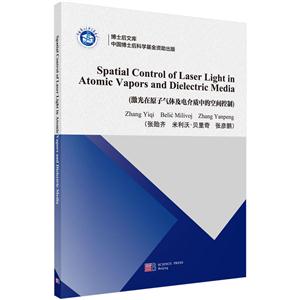-
>
(精)Round we go 360度旋转立体童话故事 (全四册英文原版 立体书)
-
>
(精)English First Dictionary 英语图解早教字典 (英英点读版)
-
>
海角-乐园-文学名著英汉双语读物-第五级
-
>
多场景全角度10000英语单词:口袋书(白金版)
-
>
(精)清儒学案-九品(全10册)
-
>
我与父辈(九品)
-
>
中国历史故事连环画(全12册)
激光在原子气体及电介质中的空间控制 版权信息
- ISBN:9787030488725
- 条形码:9787030488725 ; 978-7-03-048872-5
- 装帧:一般胶版纸
- 册数:暂无
- 重量:暂无
- 所属分类:>
激光在原子气体及电介质中的空间控制 内容简介
张贻齐、米利沃·贝里奇、张彦鹏著的《激光在原子气体及电介质中的空间控制/博士后文库》讲述了:In this book, the authors introduce their achievements in spatial control of light in atomic vaporsand dielectric media. There are five chapters in this book. In Chapter 1, the basic concepts andtheories used in this book are introduced. From Chapter 2 to Chapter 4, the authors report theirresearch results in detail. The topics include photonic topological insulators, Talbot effect, opticalrogue waves, optical vortices, azimuthons, incoherent solitons, Airy beams, Bessel beams, Fresneldiffraction, and fractional Schr6dinger equations, which are optical hot subjects in recent years. Theauthors summarize the book in Chapter 5, and meanwhile make an outlook on their future work.Whilst all the chapters are seemingly independent in form, they connect with each other in content. This book can be a reference for researchers as well as graduate students in optical physics. Inaddition, this book is also good and helpful to undergraduates majored in physics and opto-electronics.
激光在原子气体及电介质中的空间控制 目录
- >
朝闻道
朝闻道
¥9.0¥23.8 - >
推拿
推拿
¥12.2¥32.0 - >
自卑与超越
自卑与超越
¥17.1¥39.8 - >
名家带你读鲁迅:朝花夕拾
名家带你读鲁迅:朝花夕拾
¥10.5¥21.0 - >
中国人在乌苏里边疆区:历史与人类学概述
中国人在乌苏里边疆区:历史与人类学概述
¥24.0¥48.0 - >
苦雨斋序跋文-周作人自编集
苦雨斋序跋文-周作人自编集
¥6.9¥16.0 - >
二体千字文
二体千字文
¥16.0¥40.0 - >
上帝之肋:男人的真实旅程
上帝之肋:男人的真实旅程
¥19.3¥35.0
-
2022图书×抽奖盲袋
¥9.9¥25 -
2023读书月阅读盲盒——天黑,闭眼,刀谁?
¥42.3¥158 -
2022读者节纪念徽章-三星会员专属
¥45¥45.6 -
2023读书月阅读盲盒——我什么场面没见过?
¥42.3¥158 -
2023读书月阅读盲盒——去码头整点什么薯条?
¥42.3¥158















